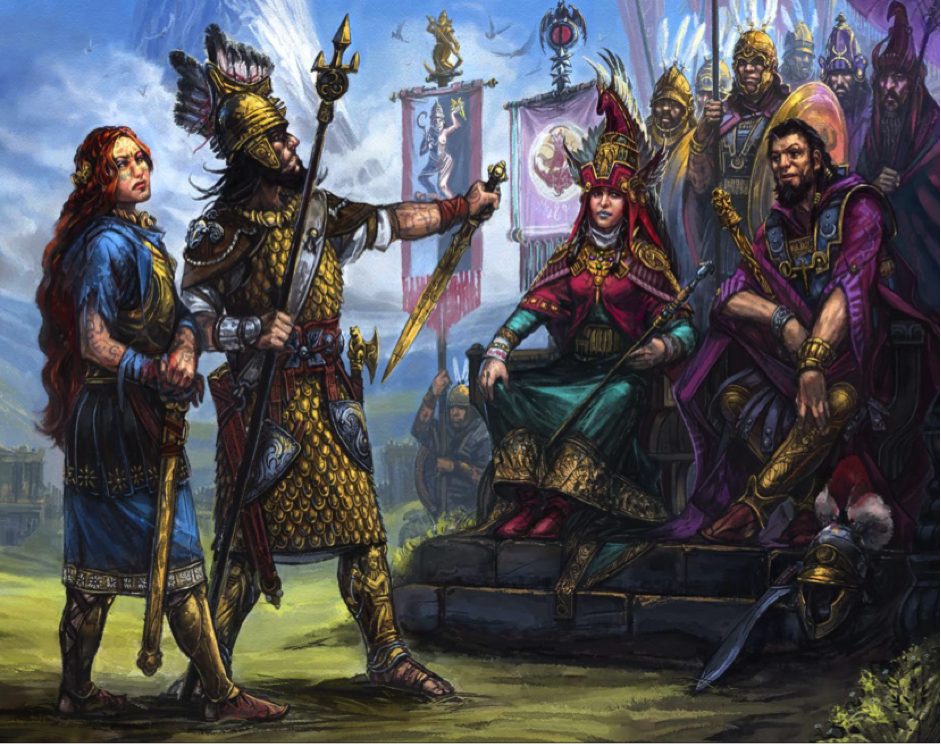Podcast: Play in new window | Download
Guest: Dr Christina Reich
Pregnant Queens of Esrolia Unite! 0:00-4:30
Today’s interviewee is Dr Christina Reich, an archaeologist and member of Jeff’s gaming group in Berlin, or, to give it its full name, the ‘Moon Design House HeroQuest Glorantha Campaign’. In both Berlin, Germany and Melbourne Australia it’s a bit rainy, causing MOB to diagnose a convergence in the time space continuum.
The Moon Design House Campaign aka thereafter ‘Jeff’s Gaming Group’ is perhaps slightly unusual in that it is a majority female gaming group. Or rather, Jeff claims it is majority female, but is then corrected by Christina who says that if you count Jeff it is fifty-fifty. The question of whether the DM is to be counted as a member of a group is then (quite wisely) left for another day. A majority (kinda) female gaming group leads to some interesting changes in plotlines. The current campaign they are playing is set in Esrolia, which is a matriarchy. This does not make that much of a difference to the storylines, but Jeff feels that there is a lot more pregnancy in their scenarios than in other groups he has played with.
Archaeology and Glorantha 4:31 – 16:20
MOB asks Christina about the influence that her background as an archaeologist has on her appreciation of the world of Glorantha. Christina feels that the main difference between Glorantha and the majority of other RPG fantasy worlds is that Glorantha is at a Bronze Age level of development, as opposed to most other fantasy worlds (e.g. Game of Thrones) that are more medieval in inspiration. Since Christina’s field of study concerns the Bronze Age, she finds that Glorantha has more to involve her than other settings.
Christina is an expert on the Bronze Age peoples of the Carpathian Basin, which starts in Hungary, and follows the route of the Danube through Slovakia down to Bulgaria. These peoples left encrusted pottery, which was often left in graves, either containing or next to human remains. The encrusted pottery is intricately decorated and often very beautiful. MOB thinks this sounds a bit Indiana Jones, as it involves looking in graves, but Christina says that she works in museums after the pottery has actually been dug up, which is much less dirty and wet than digging into graves, although, admittedly, not quite so much like Indiana Jones.
This pottery was dug up last century, and the excavator sold them to various museums. It’s now being studied to try to define a continuous culture along the Danube – although this involves not just grave goods, but also settlement structures and population proximity along the river. Although it was the Bronze Age, there was not much bronze in these graves, so it was more like the pottery age. There seems to have been as much variation in burying or scattering ashes in the Bronze Age as there are today, although there are more bones in Bronze Age funeral urns than in modern urns – Christina explains this is because Bronze Age funeral pyres weren’t as hot as a modern crematoriums.
These people were, funnily enough, called the Danubians, and they lived in the middle bronze age. The society was not literate and there are no written sources, so there is no knowledge of what they called themselves. They settled along the river, their settlements are strung along the Danube like a string of pearls. It was a river-based culture. No boats have been found, but these might not have lasted (not being made of pottery or bronze) or may be yet to be found, as there has not been much underwater archaeology in the Danube.
One of the other things that makes the Danubians hard to date is that bronze or precious metals were not left in graves, but are found concentrated in hoards. These presumably were intended as gifts to the gods, or maybe rich Danubians were just very careless… The hoards vary in size, from 10 items up to hundreds. This is an interesting way of removing wealth from society. These hoards are found all over Europe.
What does Glorantha Do Right/Wrong with a Bronze Age setting. 16:20 -21:50
MOB asks Christina what, with her background, she finds that Glorantha does right and wrong and in what ways it could be made more resonant. Christina finds this an overly philosophical question.
Archaeologists try and reconstruct worlds, but there are lots of missing pieces. With archaeology you are trying to reconstruct a world that was real, but about which the researcher may be completely wrong. With Glorantha, in contrast, you are trying to create a world, so the question of fidelity to the real world does not really apply.
That said, Glorantha is a mixture of bronze and Iron Age. You could always say that a character with late Bronze Age armour can’t have an iron sword, but Glorantha, being fictitious, does not have a problem with it.
MOB gamely tries to refine the question and asks what would happen in one of Christina’s Danubians suddenly found themselves transported to Glorantha. The problem Christina finds is that the main river-based culture in Glorantha is the Ducks, and pretty much anybody would find the Duck people challenging. Jeff feels that it would be bad to be a Gloranthan archaeologist, as if you offered a hoard to a god the god might just turn up and take it! Christina is not so sure, thinking that it would be fun to excavate the Pavis Rubble, although the presence of Trolls would be a problem that not even Indiana Jones had to deal with.
The Big Hat and the Nebra Skydisk 21:50-44:50
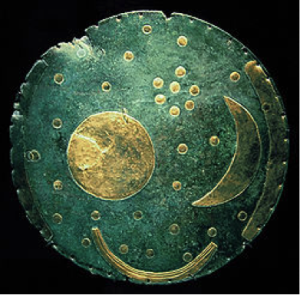
Jeff turns the question round and wants to talk about a couple of Real World artifacts that would fit perfectly well into Glorantha. The first of these is the Nebra Skydisk. This is a disk, now in Halle, is a bronze disk with a couple of golden crescents and some golden stars.
Jeff is trying to recollect what it looks like when Christina pulls it out of her bag (a copy, we are assured, not the original). The disk has among other things a depiction of the Pleiades star group. It is an astronomical instrument, that can be used to determine the solstices. While it is decorative, it is also amazingly useful, as it allowed people to determine what time to plant their crops. It is so advanced that there was some suspicion that it might have been a forgery, but it is apparently genuine.
There was a true crime story attached to it, as the original discoverers tried to sell it on the black market and were caught and charged. They were allowed to plea bargain by divulging the original site where it was found (again, this is not something that happened to Indiana Jones.) It is from about 1500 BC, or 3500 years old. This among many other finds, shows just how many cultures spent a lot of time looking at the sky – and that is the main reason there is an entire chapter on the constellations of Glorantha in the Guide to Glorantha! The disk was buried in a stone chest, and has been recognized as one of the most crucial finds of the 20th century (just, it was found in 1999).
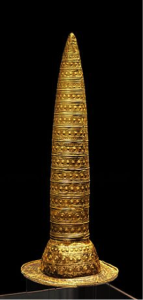
The second Bronze Age artifact that really should be Gloranthan, is the Berlin Gold Hat, which is kept in the Neues Museum on Museum Island in Berlin. The hat is made of gold, and is 98 cm high. The big hat, again, while very decorative, and very valuable, is also covered in astronomical codes. The symbols around the hat represent a lunisolar calendar. The hat has not even yet been fully deciphered but the symbols are always in calendrical calendar groups. Presumably you would not actually wear the hat while astronomical coding, although it was suggested that it could be used as an abacus, but Christina feels that is was more for showing off, and that the person who wore the hat was saying ‘I know when to plant crops. Ask me how!’ There are other gold hats, but the Berlin one is the most important.
Unfortunately, it is not exactly known where the Berlin hat was found, as it was bought on the art market. It is not even known where most of these hats were found, but there is an 18th century engraving about the finding of a gold hat in Wessex, England. Where it came from is perhaps not so important, as that there is evidence that the European elite of the Bronze Age, like now, had strong connections. While the hats are very large, they are almost as thin as paper, and so are actually quite practical to wear (or as much as a 98 cm hat can be). Quite how such fragile hats survived is not known, but perhaps like the sky disk they were buried in a stone chest. One gold hat was almost completely destroyed by a workman’s axe before he realised he was destroying a priceless gold artifact.
Jeff speculated which Gloranthan cultures would have that much gold. Christina replies that the issue is not so much having the gold, as having someone who is able to hammer gold as flat as paper. One of the things that the owner of the hat would be able to do is predict eclipses, which of course allows you to predict when the wolf is going to eat the sun, and then be able to tell the wolf to give it back again.
MOB points out however that there is a danger in wearing the biggest hat in the room. In the Byzantine period, some Veringovians were bribed to kill the emperor. They walked into Hagia Sophia, and immediately started hacking to death the guy with the biggest hat. Unfortunately for them, this was some random (big-hatted) Bishop, and the slightly less well-hatted Emperor got away unscathed.
Which Bronze Age Culture had the Prettiest Stuff 44:50 – 58:15
Jeff frequently borrows photo books of archeological finds from Christina, to show to his artists as reference material and inspiration for artworks for Moon Design publications. He therefore asks Christina what Bronze Age culture she feels had ‘the prettiest stuff’. This is clearly not a technical archaeological term. Not surprisingly, Christina likes the culture that she did her PhD on, but also the Nordic circle, who lived from Berlin north into Scandinavia. They made lovely decorative artifacts including belt disks and grave pins.
Jeff then pulls out the Guide to Glorantha. One of Christina’s favourite illustrations from the Guide is in the Dragon Pass section, on page 169. It is of the Feathered Horse Queen, and is clearly inspired by Scythian burial illustrations, although she feels that the hat should be higher! Jeff then instructs Jan Pospesil to draw larger hats. Big hats and big hair were big in the Bronze Age, with some hairdos being over a meter high.
On page 35-36 there is an Orlanthi scene of a female warrior depositing a severed head. This was done by Mike Perry. The decoration on the back wall in this piece is Hittite inspired.
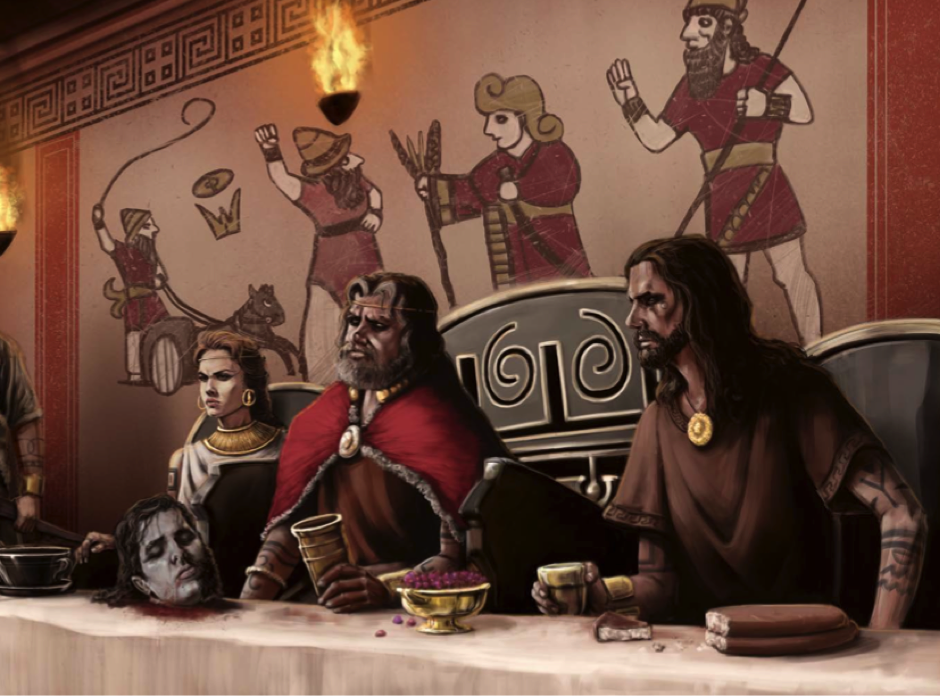
The final picture considered is on page 344, a Manirean scene, the conversion of Talestar to the Lunar religion (White Shirt Day). This picture is by Jan Pospesil again.
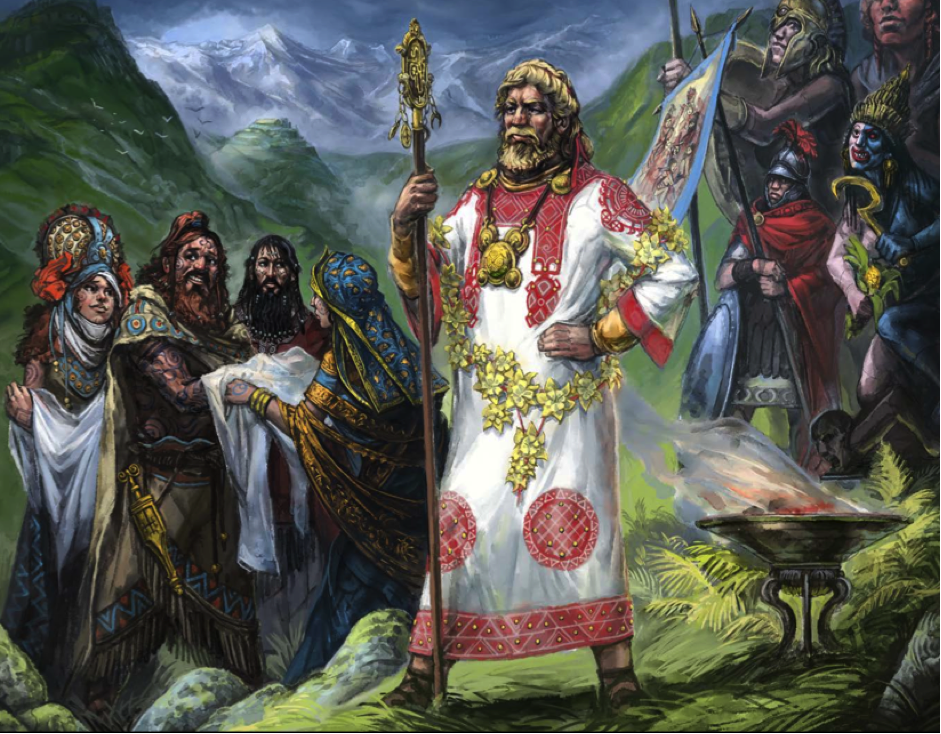
Conclusions MGF Questions Christina 58:15-
Rob the producer breaks in to wonder what he wants to be when he grows up. An underwater archaeologist or an astronomical hat coder.
Q: Better than the average gamer
A: Christina heals everybody.
Q: Worse than the average gamer
A: Christina feels that she is maybe not the most solution oriented of players.
Q: One thing everybody knows about Christina
A: That she is very reliable.
Q: One thing nobody knows about her
A: She plays underwater rugby.


